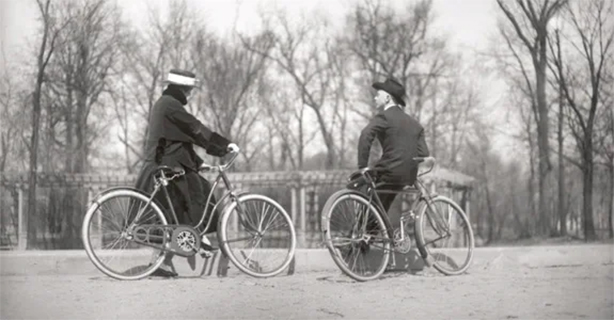PUTTING THE WORK BACK IN: HARLEY-DAVIDSON™ BICYCLES
It is sometimes reported that the original Mr. Harley and three Mr. Davidsons said they started Harley-Davidson to “take the work out of bicycling.” Though true, this statement is sometimes misconstrued to suggest that Harley-Davidson started as a bicycle company. This is simply not the case.
What is undeniably true, however, is that bicycles had a major influence on the Motor Company during those early years. The very first vehicles, after all, were essentially motor-driven bicycles.
Despite their best efforts to promote a better way to travel on two wheels, standard bicycles continued to grow in popularity in the 1910s. With an eye on introducing new markets to motorcycling, Harley-Davidson decided to sell its own brand of bicycle, through an unlikely partnership with a sewing machine company.
THE RISE OF LEISURE BIKING
At the turn of the century, increasing numbers of people turned to bicycles as a primary means of getting around. But over the next two decades, motorcycles and cars increased in popularity.
Since both of them provided longer range, better speed, and more practicality, the bicycle—which earlier had been a popular means of short-distance transportation—took on a new role. A bicycle sales boom in the 1910s brought with it new potential for leisure-time riding.
A DEAL WITH DAVIS SEWING MACHINE CO.
With its lower price and ease of use, it could also serve as a means for introducing younger people to the Harley-Davidson® motorcycle. These conditions led to the signing of a deal with Davis Sewing Machine Co. of Dayton, Ohio in the autumn of 1916.
With the rise of the motorcycle in the 1900s and 1910s, Davis already had its own motorcycle brand, the Dayton, which capitalized on the established Dayton bicycles, going back to 1892. (The Dayton bicycle evolved into the Huffman and later Huffy brand).
According to the agreement, Davis sold the main component parts of the bicycles and shipped them to Milwaukee for assembly. Harley-Davidson dedicated an entire building for production across the railroad tracks from the Milwaukee factory on Juneau Avenue.
Beginning in 1917, bicycles were sold mainly through Harley-Davidson’s motorcycle dealerships, though bicycle dealers filled that role in smaller towns that had limited access to H-D® dealers.
H-D™ BICYCLE CHARACTERISTICS
Characteristic to H-D™ bicycles was the familiar olive-green paint adorning the motorcycles since World War I. The bikes also had another hallmark, the letters H and D cast into the main sprocket in the same way Dayton bicycles read DAYTON.
Bicycle names included the “Diamond Frame,” “Ladies Standard,” “Boy Scout,” “Girls Juvenile,” “The Racer,” and “7-17 Special.” The Boy Scout was ultimately renamed, perhaps due to objections from the Boy Scouts of America.
The “Motorcyke” was the most reminiscent of a motorcycle, with a metal tank situated along the two top tubes in the frame. But this tank held a different power source: batteries for the headlamp.
The bikes brought unique marketing opportunities. Even more than any motorcycle that rolled out of Milwaukee, young people could own a Harley-Davidson™ bicycle more easily than ever, with the right amount of hard work and saving. (And for the Motor Company, the bicycles also allowed for a tidy revenue stream over the winter months, specifically leading up to Christmas). Adults with city commutes were encouraged to save money from the “high cost of streetcar riding.”
And the health benefits were obvious: “Muscles will harden, color will come back to the cheeks, insomnia will be a thing of the past. Legs, back, arms and brain are better for it.” But the health benefits did not stop there. Ads from 1920 also referred to the streetcar as “germ laden.” With the catastrophic influenza pandemic of 1918 still fresh in America’s memory, the bicycle kept the rider healthy in more ways than one.
Harley-Davidson’s line of accessories was expanded to include items for bicycle owners, including gas and electric headlamps, horns, and compact frame-mounted hand pumps for the inner tubes. Any other needed item, including tools, was available.
SHORT-TERM SUCCESS
Sales were a blip on the H-D radar by 1920, the peak year, at only about four percent of overall domestic sales. It is also believed that sales never matched those of competitors due to limitations of the motorcycle dealer network.
However, the bikes were a quality ride. Evidence lies in favorable product reviews and the premium price points, which ranged from the low $40s to the mid $50s. Ultimately, the bicycle family was a casualty of the recession of 1920-1921, which led to reductions in expenses.
As an epilogue to the short-lived bicycle line, Harley-Davidson learned in 1922 that Davis Sewing Machine Co. continued to produce and sell bicycles with the Harley-Davidson badge on them—nearly one full year after the Motor Company had called an end to bicycle sales.
After a cease-and-desist letter failed to cease or desist anything, the illegal activity was finally stopped by a personal visit from Arthur Davidson in the spring of 1923.
RETURN OF THE BICYCLE
In 2020, Harley-Davidson revisited this history, partnering the iconic style and innovative spirit of the oldest Harley-Davidson motorcycle, nicknamed Serial Number One, with modern technology to create the Serial 1, a brand of electric bicycles powered by Harley-Davidson.

